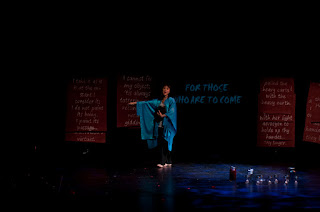 |
| Tarik O'Regan - photo credit Luca Sage |
 |
| Hai-Ting Chinn photo credit Rodrigo Lopresti |
The Wanton Sublime was premiered in 2014 at Roulette which Tarik describes as a fantastic venue in Brooklyn. It was produced by Robert Shaw with mezzo-soprano Hai-Ting Chinn who will also be performing the UK premiere, an apt confluence as she is also working on something in London at the Tete a Tete Opera Festival this summer. Having the same singer in the NY and London productions is useful because the piece uses a small amount of pre-recorded music as Tarik wanted the audience to be unsure whether they were listening to live or recorded as the singer interacts with her recorded self.
The work is written for string quartet (violin, viola, cello and double bass), two percussion, flute and two guitars (mixing electric and acoustic, with the electric guitar using lots of pedals and effects). In order to achieve a suitable balance particularly between acoustic and electric guitars, everything was amplified in New York but in venue the size of Arcola Theatre, Tarik said that he would be happy not to use amplification.
 |
| Hai-Ting Chinn in The Wanton Sublime in 2014, premiere at Roulette, NY |
Tarik points out that there is so little Biblical source material about the Virgin as opposed to the massive amount of iconographic information. Anna Rabinowitz was interested in the gap between the Virgin's difficult life and the serenely peaceful way she is depicted in the iconography. Tarik has mirrored this in writing the piece with intense, dark music contrasted with aetherial music. Another issue which Tarik took from Anna Rabinowitz's book was how the iconography was determined by men and how little female representation of the Virgin there was.
Tarik describes himself as not religious at all. He is of mixed heritage, with a North African mother and an English father of Irish extraction, and was not pushed in any particular direction when growing up. But he feels that even those who don't believe can appreciate the beauties present, and when writing liturgical music he is always aware of those for whom he was writing.
Though the small scale compact The Wanton Sublime might seem rather different to Tarik's previous opera, Heart of Darkness but Tarik feels there are links. When writing Heart of Darkness he experimented by adding guitars because, at the time, he was working on an album for Paul Hillier which used guitar. In Heart of Darkness the guitar combined with other instruments to create the river music. In The Wanton Sublime he used both the electric guitar and acoustic guitar to encapsulate the difference between the angry and the sublime. Also, the way in The Wanton Sublime the older Virgin looks back at her younger self and her Iconography mirrors the structure of Heart of Darkness with an old man looking back at events. Tarik describes the music of The Wanton Sublime as 'gnarlier' than Heart of Darkness but says that there are still beautiful moments.
His next stage work is something completely different, a ballet based on the life of Mata Hari for Dutch National Ballet. This is a huge piece, 100 minutes of music, and premieres in February 2016, with choreography by Ted Brandsen, Dutch National Ballet's artistic director. Tarik does have another music theatre piece in the planning stages, but is reticent about it till plans are firmed up
He is recording a disc of orchestral music, including the Heart of Darkness Suite, for NMC with the Halle. To be released at the end of 2015 or early 2016, the disc will be conducted by Mark Elder and the young conductor Jamie Philips, and Tarik rather likes that the disc involves conductors at different ends of their careers. he feels that is always good to work with different conductors and that it helps a composer realise that a piece really does live, you can realise how different it can be. Yet, as he puts it, nothing has changed and for Tarik this points up a big difference between concert music and pop music. In the classical concert world in live performance the score stays the same but the interpretations are wildly different, whilst in the pop world there is a huge recording presence and it is the recording which stays the same.
This leads us to talking about the changes in the classical musical world, and we finish on an upbeat note as Tarik comments that he finds it relatively cheering that things are changing and will settle down. He sees this as a good thing, as we can get set in our ways.
Elsewhere on this blog:
- Mesmerising theatre: Handel's Saul at Glyndebourne - opera review
- Magical: Opera Holland Park's Alice on disc - CD review
- Luscious, endless: Charpentier's Louise in Buxton - opera review
- Huddersfield Choral Society: Rachmaninov Vespers in Buxton - concert review
- Mafioso Lucia di Lammermoor at Buxton - Opera review
- Fascinating but flawed Verdi's Giovanna d'Arco at Buxton - Opera review
- Engaging: Purcell's King Arthur from Paul McCreesh and the Gabrieli Consort and Players - concert review
- Lesser known but rewarding: Palestrina's Missa L'Homme Arme from the Sixteen - Cd review
- Brilliant exploration: Romaria: Choral Music from Brazil - CD review
- Thoughtful Bastille Day: Arcangelo at the Wigmore Hall - concert review
- Charm overload: Music for Piano and Harp - CD review
- Finely satisfying: Eugene Onegin at Grange Park Opera - Opera review
- An alternative view: Iberian Colours from the Maria Camahort Quartet - CD review
- Home



%20and%20kids.jpg)
.webp)


.jpg)



No comments:
Post a Comment